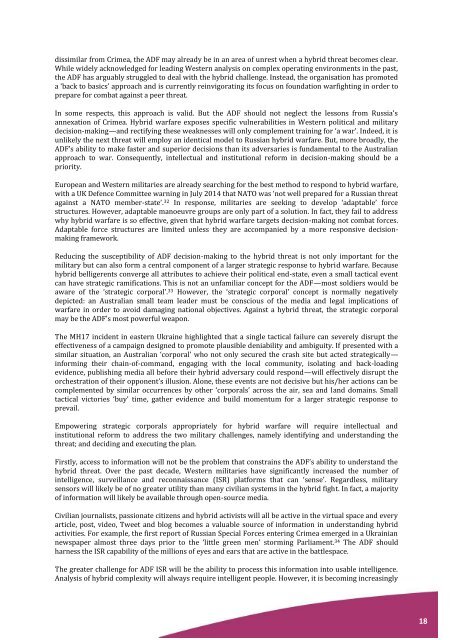Issue No 198 2015
198 2015 Nov_Dec
198 2015 Nov_Dec
You also want an ePaper? Increase the reach of your titles
YUMPU automatically turns print PDFs into web optimized ePapers that Google loves.
dissimilar from Crimea, the ADF may already be in an area of unrest when a hybrid threat becomes clear.<br />
While widely acknowledged for leading Western analysis on complex operating environments in the past,<br />
the ADF has arguably struggled to deal with the hybrid challenge. Instead, the organisation has promoted<br />
a ‘back to basics’ approach and is currently reinvigorating its focus on foundation warfighting in order to<br />
prepare for combat against a peer threat.<br />
In some respects, this approach is valid. But the ADF should not neglect the lessons from Russia’s<br />
annexation of Crimea. Hybrid warfare exposes specific vulnerabilities in Western political and military<br />
decision-making—and rectifying these weaknesses will only complement training for ‘a war’. Indeed, it is<br />
unlikely the next threat will employ an identical model to Russian hybrid warfare. But, more broadly, the<br />
ADF’s ability to make faster and superior decisions than its adversaries is fundamental to the Australian<br />
approach to war. Consequently, intellectual and institutional reform in decision-making should be a<br />
priority.<br />
European and Western militaries are already searching for the best method to respond to hybrid warfare,<br />
with a UK Defence Committee warning in July 2014 that NATO was ‘not well prepared for a Russian threat<br />
against a NATO member-state’. 32 In response, militaries are seeking to develop ‘adaptable’ force<br />
structures. However, adaptable manoeuvre groups are only part of a solution. In fact, they fail to address<br />
why hybrid warfare is so effective, given that hybrid warfare targets decision-making not combat forces.<br />
Adaptable force structures are limited unless they are accompanied by a more responsive decisionmaking<br />
framework.<br />
Reducing the susceptibility of ADF decision-making to the hybrid threat is not only important for the<br />
military but can also form a central component of a larger strategic response to hybrid warfare. Because<br />
hybrid belligerents converge all attributes to achieve their political end-state, even a small tactical event<br />
can have strategic ramifications. This is not an unfamiliar concept for the ADF—most soldiers would be<br />
aware of the ‘strategic corporal’. 33 However, the ‘strategic corporal’ concept is normally negatively<br />
depicted: an Australian small team leader must be conscious of the media and legal implications of<br />
warfare in order to avoid damaging national objectives. Against a hybrid threat, the strategic corporal<br />
may be the ADF’s most powerful weapon.<br />
The MH17 incident in eastern Ukraine highlighted that a single tactical failure can severely disrupt the<br />
effectiveness of a campaign designed to promote plausible deniability and ambiguity. If presented with a<br />
similar situation, an Australian ‘corporal’ who not only secured the crash site but acted strategically—<br />
informing their chain-of-command, engaging with the local community, isolating and back-loading<br />
evidence, publishing media all before their hybrid adversary could respond—will effectively disrupt the<br />
orchestration of their opponent’s illusion. Alone, these events are not decisive but his/her actions can be<br />
complemented by similar occurrences by other ‘corporals’ across the air, sea and land domains. Small<br />
tactical victories ‘buy’ time, gather evidence and build momentum for a larger strategic response to<br />
prevail.<br />
Empowering strategic corporals appropriately for hybrid warfare will require intellectual and<br />
institutional reform to address the two military challenges, namely identifying and understanding the<br />
threat; and deciding and executing the plan.<br />
Firstly, access to information will not be the problem that constrains the ADF’s ability to understand the<br />
hybrid threat. Over the past decade, Western militaries have significantly increased the number of<br />
intelligence, surveillance and reconnaissance (ISR) platforms that can ‘sense’. Regardless, military<br />
sensors will likely be of no greater utility than many civilian systems in the hybrid fight. In fact, a majority<br />
of information will likely be available through open-source media.<br />
Civilian journalists, passionate citizens and hybrid activists will all be active in the virtual space and every<br />
article, post, video, Tweet and blog becomes a valuable source of information in understanding hybrid<br />
activities. For example, the first report of Russian Special Forces entering Crimea emerged in a Ukrainian<br />
newspaper almost three days prior to the ‘little green men’ storming Parliament. 34 The ADF should<br />
harness the ISR capability of the millions of eyes and ears that are active in the battlespace.<br />
The greater challenge for ADF ISR will be the ability to process this information into usable intelligence.<br />
Analysis of hybrid complexity will always require intelligent people. However, it is becoming increasingly<br />
18


